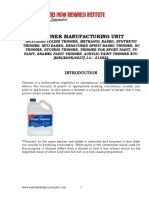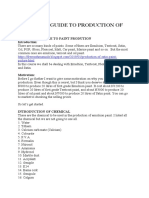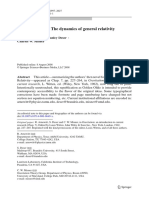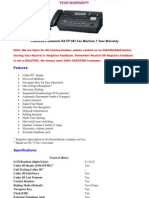Acrylic Paint. Making
Acrylic Paint. Making
Uploaded by
Rodrigo R.BCopyright:
Available Formats
Acrylic Paint. Making
Acrylic Paint. Making
Uploaded by
Rodrigo R.BCopyright
Available Formats
Share this document
Did you find this document useful?
Is this content inappropriate?
Copyright:
Available Formats
Acrylic Paint. Making
Acrylic Paint. Making
Uploaded by
Rodrigo R.BCopyright:
Available Formats
Acrylic Paint http://www.paintmaking.com/grinding_acrylics.
htm
Preparation Predispersal requirements etc Attempting to make Acrylic Paint from base ingredients is difficult but the following method based on using pre made acrylic mediums is fairly straightforward. It has the advantage that the same basic technique can easily be adapted to make a huge range of paint qualities and characteristics from thin ink-like fluids to thick textural constructional pastes. Gouaches and Watercolor like paints are easy to make as well as more conventional thicker Acrylic Paints. Pigments should be predispersed using distilled water and Surface Tension Breaker. About 50/50 liquid to pigment will make a suitable paste. Several pigments will disperse very easy. Ultramarine is probably the easiest, but some of the synthetic organics such as Quinacridone will be uncooperative. The easy to disperse pigments are best dispersed by simpling mixing in a plastic container with a spatula (see below) but the difficult pigments will be best mulled on the slab. Golden sell a product called Universal Dispersant that is particularly good at wetting the pigment and maintaining the long term stability of the pigment dispersion. There are some problems to watch out for:
Foaming. The Acrylic emulsion already contains surfactants. Like dishwashing detergent they foam easily. Use of defoaming agents may be necessary. Drying. Like when making Watercolor drying can occur (especially at the edges) during dispersal and needs to be avoided. Overuse of modifiers. Too much defoamer can be a problem, same with Retarder, take care when measuring. Maintaining alkalinity. The pH can easily fall as ingredients are added and the paint will cease to be viable paint beyond a certain point. Increase pH with ammonia. The hydrophobic nature of pigments. Use wetting agents or even a little Grain Alcohol to wet the pigments.
You will find a straight sided 1 liter (2 pints) plastic bucket with a flat bottom the ideal mixing container that is not too big, not too small. An eyedropper is valuable for adding small amounts of liquids like ammonia or defoamer. A plastic spray bottle can help keep the paint wet during mulling. Related Links: Ingredients for Acrylic paints
Pigments
Grinding or mixing Also called dispersal The proportion of pigment to binder varies according to the pigment from 40% to 60%. It is possible to add more pigment but beyond a certain point this will reduce adhesion and durability of resulting paint films. The trick is in finding that sweet spot that is optimal for each pigment. In general the percentage of mineral based pigments like Ultramarine will be higher, while the percentage of organic pigments will be lower. Manufacturers tend to be secretive about their exact formulations so a little personal experimentation is required. The good news is that the latitude is wide in Acrylics and generally if you are going to have a problem with a paint the problem will be apparent as soon as the paint dries. It is at the initial mixing stage that matting agents should be added. It is advisable to make a couple of small amounts of paint with an easy to use pigment with varying portions of matting agent in order to arrive at the portion that suits you. As always when making paint note everything down as it is easy to forget or get confused about amounts. Most mineral type pigments disperse easily from the pigment paste into the chosen Acrylic binder by mixing with the spatula in the bucket. Start with 50/50 and then add more as the mixing proceeds. At first the paint will seem to get thicker then after vigorous beating the paint will become noticeably smoother. It is important to make certain that there are no areas of the container on the bottom or edges that are not so well mixed as the rest. Test with a drawdown Organic pigments may well require mulling. Start in the bucket with a little less than half pigment to binder then add pigment paste as necessary. Use drawdowns as necessary to check dispersal. If necessary pour a little on the slab and mull in a circular motion, scraping the paint into the center and from the edge of the muller as necessary. Work quickly but be wary of foaming. Use a spray bottle to keep moist if needed, but don't over wet. Making Acrylics is often better done at night as the humidity is higher and drying less an issue. Defoamer should never be more than 1% of paint volume. Retarder never more than 15%. It is important to monitor pH as when the pH falls below 8 the paint can become more like cheese than paint. If this happens just throw it out, it is ruined. To monitor pH it is possible to use litmus papers I guess, but the smell test is easier. At the correct pH the paint will have a distinctive ammonia like smell and will lose it as the pH lowers. Adding ammonia a few drops at a time will retain the appropriate alkalinity, ideally between 8 and 9. Rheology needs to be considered here. Acrylic paint can vary from thick and honey like, as in automotive paints. This is 'long' rheology. Less resinous, and less stringy paint has 'short' rheology. This is not the exact equivalent of the terms long and short in oil paint where the one kind of
buttery quality is sought. In acrylics it may be desirable to make a variety of rheologies.For example it is possible to have high viscosity with either short or long rheology and the same for lower viscosity paints. Each has a role and only artist preference dictates which is best in any given situation. Fortunately Golden makes thickeners of both long and short rheology that make this kind of formulation choice easy. The degree of fluidity, the level of surface sheen, speed of drying and so on can all be modified considerably. As this is more to do with personal taste than practical issues such things should be left to individual experimentation. Available products can be found here Technical support is often provided by Acrylic manufacturers. [ Go to Testing paints ]
Filling tubes and jars Storing paint Having made your Acrylic paint the storage method needs to be decided on. Tubes are popular and easy to use but larger quantities of paint may require storage in plastic buckets. Putting a sheet of Gladwrap over the paint surface helps prevent surface drying.
Acrylics Polymer resin emulsions
Acrylics began life early in the 20th century and have gone on to produce a wide range of products. Long before there were any Acrylic artist's paint Acrylic was replacing glass in World war 2 fighter planes and acrylic fibers were being woven into textiles. Acrylic emulsions were first used as house paints which were made famous artistically when they were used by Jackson Pollock, but it was not until after Pollock's death that the first artist's acrylics became widely available. Making Acrylic paints is not so simple as the traditional products like oil and Tempera. However very serviceable paints can be ground in the prepared Acrylic mediums sold by the artist's paint manufacturer. As these come in a wide range of viscosity and other properties it is easy to vary the mixtures to suit individual needs. Taking this approach makes making Acrylic paints little more difficult than making Tempera. Unlike Tempera, however, a far wider range of paints can be made from thick impasto paints to tough thin vehicles for glazing and iridescent coatings or whatever. The keyword is imagination. There has never been an artist's paint medium with such versatility before, able to have such a wide range of personalities and abilities. Below are just a few of the many Acrylic mediums that can be used to grind pigments into. Often they will have different names depending on the manufacturer. It is usually relatively easy to phone a local Acrylic paint manufacturer for more detailed information on their products. There are numerous choices offering a wide range or surface sheen, texture, viscosity and so on As an indication of what is available here is a link to the mediums pages for Goldenand Matissewhose specialties are some of the widest ranges of Acrylic mediums on the market. The various modifying agents like wetting agents and spreaders are readily available from any artist supply store, but some like matting agents or defoamers are not so easy to get. Golden paints supply virtually everything required. Apart from that I would sugest phoning your local Acrylics manufacturer. It has been my experience that the makers of Acrylic paints, especially American and Australian manufacturers, are generally helpful and have friendly technical support departments. The specialist Acrylics manufacturers tend to be very open to experimentation. Related Links:
Oil binders Gums Eggs Waxes and natural resins
Binder Medium The basic Acrylic medium
This is the pure acrylic resin without modification so it is a thin milky liquid that dries to a tough flexible film that is the strongest and most durable of the Acrylic paint films. Pigment can be ground directly into Binder Medium, or the binder can be freely mixed with other mediums to increase resin content. My personal favorite is to mix 125 ml of Binder Medium to 1 liter of Gel Medium. On its own this makes a fabulous glue that is perfect For gluing canvas to panels because it is nice and thick, and is great as a general purpose glue as well. As a medium for making paint I like the brushing qualities that result.
Gel Medium Thick, transparent, and glossy
Makes a good strong paint film with maximum brilliance of colors. The addition of spreader medium will increase flow properties.
Impasto Medium The base for thicker paints
Impasto medium does not dry perfectly clear as it has a solid content already. So it is the starting point for making acrylic gouaches with the addition of precipitated chalk or for adding calcite to make thick modeling style pastes.
Iridescent Medium For special effects
Iridescence can be added to any pigment by using Iridescent medium. It is basically Acrylic binder with Mica Titanate added that gives the iridescent sparkle to any color ground in this medium. Transparent pigments will have a greater iridescence and opaque pigments less so.
Modifiers Retard, spread, break surface tension etc
Retarder Retarder mediums adjust drying speed by replacing water with a liquid that drys more slowly than water. Useful up to a point but too much can create a paint that won't dry properly. Spreader or Thickener This adjusts the flow and leveling qualities of the paint (technically called rheology). Thickeners are available with both short and long rheology. Defoaming agents these are silicones that combat the surficants within the Acrylic which have a tendency to foam during dispersal by popping bubbles as they form. Overuse causes 'cratering'. Matting agents This is silica and in the case of making Acrylic paint the naturally derived crystaline version is better than the synthetic 'amorphous' type. Wetting agent Often called Surface Tension Breaker's these are valuable for wetting the synthetic organic pigments during predispersal of the pigments. Calcite Calcite can be freely mixed with the acrylic to make a modeling paste or paint that holds brushstrokes easily.
Ammonia This can be just the Cloudy Ammonia from the supermarket. As you make paint the pH level may fall. Acrylic paint exhibits ideal paint qualities between pH levels of 8 and 9 (water is 7) and if the pH gets too low the paint goes funny and can be ruined. A little Ammonia helps return the alkalinity the paint needs.
References
Feller, R L, Artists Pigments 1986 (National Gallery Of Art / Cambridge University) Gottsegen, M D, A Manual Of Painting Materials And Techniques, 1987 (Harper & Row) Mayer, R, The Artists Handbook Of Materials And Techniques, fifth edition 1991 (Faber& Faber) Patton, T C, Pigment Handbook, 1973 (Wiley) Roy, A Artist's Pigments: A Handbook Of Their History And Characteristics, 1994 (Oxford University Press) Taubs, F, A Guide To Traditional And Modern Painting Methods, 1963 (Thames & Hudson) Various, Encyclopedia Britannica, fifteenth edition 1981 (Encyclopedia Britannica, Inc) Various, Paint And Painting, 1982, (Winsor & Newton / The Tate Gallery) Various, The Artist's Colormen's Story, 1984 (Winsor & Newton)
You might also like
- A Complete Guide To Production of PaintDocument8 pagesA Complete Guide To Production of PaintEkeh Victor Chibueze92% (12)
- Solution Manual For Introduction To Fluid MechanicsDocument1,428 pagesSolution Manual For Introduction To Fluid MechanicsSilvio Roberto Attanasio100% (6)
- Paints and Coatings With Formulations Technology Book PDFDocument15 pagesPaints and Coatings With Formulations Technology Book PDFMOHAMED100% (1)
- Exterior Paint FormulationDocument1 pageExterior Paint FormulationSrun BunsroeunNo ratings yet
- Thinner Manufacturing UnitDocument10 pagesThinner Manufacturing UnitEIRI Board of Consultants and Publishers100% (1)
- Flexo and Gravure Inks FormulationDocument14 pagesFlexo and Gravure Inks FormulationMd Ali RazuNo ratings yet
- Shrink Sleeve PVC InksDocument1 pageShrink Sleeve PVC InksPRAVIN A.PANDHARKAMENo ratings yet
- Paint ProductionDocument40 pagesPaint ProductionNemerem Ignatius86% (7)
- Talc in Polyester Putties - Mondo Minerals PDFDocument10 pagesTalc in Polyester Putties - Mondo Minerals PDFJuanan Lopez100% (1)
- Complete Guide To Production of PaintDocument23 pagesComplete Guide To Production of PaintAGBELUSI ABIODUN100% (1)
- Production of Paint From Locally Sourced Raw MaterialsDocument7 pagesProduction of Paint From Locally Sourced Raw MaterialsInternational Journal of Science and Engineering Investigations0% (2)
- Paint Making ProcessDocument7 pagesPaint Making ProcessXm Quit50% (2)
- Modern Technology of Printing Inks: Price: Availability: in Stock Isbn Number: Writer: Publisher: Average RatingDocument4 pagesModern Technology of Printing Inks: Price: Availability: in Stock Isbn Number: Writer: Publisher: Average RatingeiribooksNo ratings yet
- Emulsion Paint ProductionDocument2 pagesEmulsion Paint Productionnarayan_umalla86% (7)
- Water Based Decorative CoatingsDocument46 pagesWater Based Decorative CoatingsHo Hai Nam100% (3)
- ThinnerDocument9 pagesThinnereiribooksNo ratings yet
- Emulsion PaintDocument1 pageEmulsion PaintFazlul HoqueNo ratings yet
- Resins For Surface Coatings Vol 2Document161 pagesResins For Surface Coatings Vol 2Lelecos100% (10)
- LABORATORY STUDIES On Paints ProductionDocument22 pagesLABORATORY STUDIES On Paints Productionekojamichael100% (1)
- Part 7. Inks VarnishesDocument9 pagesPart 7. Inks VarnishesSukshamNo ratings yet
- Paint, Varnish, Solvent, Thinner, Coating and Lacquers Technology-BooksDocument2 pagesPaint, Varnish, Solvent, Thinner, Coating and Lacquers Technology-BooksKomal Srivastava60% (5)
- L170R41 eDocument142 pagesL170R41 eJairo Morales100% (2)
- PaintDocument4 pagesPaintgreatgenius100% (3)
- Paint Ebook MainDocument40 pagesPaint Ebook MainugvickoNo ratings yet
- Paint Manufacturing Process: PigmentsDocument7 pagesPaint Manufacturing Process: PigmentsTamr KasayeNo ratings yet
- Acrylic Binders For Low Voc PaintsDocument31 pagesAcrylic Binders For Low Voc PaintsMaina1206567% (3)
- Preview of "How To Make Oil Paint by Tony Johansen"Document3 pagesPreview of "How To Make Oil Paint by Tony Johansen"WriterInc100% (2)
- Paints Pigments and Industrial CoatingsDocument10 pagesPaints Pigments and Industrial CoatingsRaymond FuentesNo ratings yet
- Binders PDFDocument1 pageBinders PDFFriska Ayu LigoyNo ratings yet
- 1-A Colored Substance That Is Spread Over A Surface and Dries To Leave A Thin Decorative or Protective Coating. Decorative or Protective CoatingDocument60 pages1-A Colored Substance That Is Spread Over A Surface and Dries To Leave A Thin Decorative or Protective Coating. Decorative or Protective Coatingjoselito lacuarinNo ratings yet
- How To Mix Colors in Paint ProductionDocument17 pagesHow To Mix Colors in Paint ProductionBachir Ismail100% (1)
- SATIN PRODUCTIO-WPS OfficeDocument3 pagesSATIN PRODUCTIO-WPS OfficeMustafa Chirwa100% (3)
- Chapter 3 Traffic Paint: ObjectivesDocument10 pagesChapter 3 Traffic Paint: ObjectivesCloudy DayNo ratings yet
- Dow Ink FormulationsDocument3 pagesDow Ink FormulationskarkamalusNo ratings yet
- Printing Ink and Overprint VarnishDocument137 pagesPrinting Ink and Overprint VarnishSutopo100% (2)
- Paints - Lecture 2Document18 pagesPaints - Lecture 2rughupaty govindaNo ratings yet
- 20 Different Types of Paints Used For Interior and Exterior SurfacesDocument13 pages20 Different Types of Paints Used For Interior and Exterior SurfacesdavesterdaveNo ratings yet
- Printing Ink Final Project LavinaDocument36 pagesPrinting Ink Final Project LavinaLavina Gurbani100% (1)
- Paint AdditivesDocument3 pagesPaint AdditivesAnonymous yy8In96j0rNo ratings yet
- Use of Soya Lecithin in Making PaintDocument1 pageUse of Soya Lecithin in Making PainttunlajiNo ratings yet
- Printing Ink and ManufactureDocument13 pagesPrinting Ink and ManufactureD Rong sa100% (1)
- What Is Emulsion PaintDocument10 pagesWhat Is Emulsion Paintabdilquadri ishaqNo ratings yet
- Polishes, Coatings and SealersDocument30 pagesPolishes, Coatings and SealersIdkaNo ratings yet
- Paint 24442Document8 pagesPaint 24442DeDexterNo ratings yet
- CHM441Document30 pagesCHM441Shivpoojan SinghNo ratings yet
- Formulation andDocument9 pagesFormulation andAsadoumo AbrahamNo ratings yet
- Alkyd Resins: Nishad Vaidya Praveenkumar MDocument16 pagesAlkyd Resins: Nishad Vaidya Praveenkumar Msomesh bhagure100% (1)
- Interior Paint FormulationDocument1 pageInterior Paint FormulationSrun Bunsroeun100% (1)
- Glossy FillersDocument6 pagesGlossy Fillerskensley oliveira100% (1)
- Water Based Flexo InksDocument5 pagesWater Based Flexo InksAshish JainNo ratings yet
- Chemical Formulations For Acrylic Matt and Acrylic Gloss PaintsDocument12 pagesChemical Formulations For Acrylic Matt and Acrylic Gloss PaintsDean Hidayat100% (1)
- Characterization of Paint Formulated Using SecondaDocument8 pagesCharacterization of Paint Formulated Using SecondasiaNo ratings yet
- Economic PaintDocument1 pageEconomic PaintForeverNo ratings yet
- Water Based Gravure Printing InkDocument6 pagesWater Based Gravure Printing InkHiba Naser100% (1)
- Pigments For Printing InksDocument49 pagesPigments For Printing Inksplast_adesh75% (4)
- Acrylic EmulsionsDocument15 pagesAcrylic EmulsionsAsim Meraj100% (1)
- Road Marking Paints PDFDocument9 pagesRoad Marking Paints PDFThomas Gunawan100% (1)
- Aluminium PigmentsDocument24 pagesAluminium Pigmentsmita shilNo ratings yet
- Ink TypesDocument10 pagesInk TypesRaja SekarNo ratings yet
- Acrylic Painting Guide for Beginners: An In-depth Manual to Mastering Painting with Acrylics, Tools and Materials with easy to understand Techniques and Starter ProjectsFrom EverandAcrylic Painting Guide for Beginners: An In-depth Manual to Mastering Painting with Acrylics, Tools and Materials with easy to understand Techniques and Starter ProjectsNo ratings yet
- Mediapedia AcrylicsDocument4 pagesMediapedia AcrylicsEduardo PujolNo ratings yet
- Acrylic Tips For BeginnersDocument4 pagesAcrylic Tips For Beginnerssneha100% (2)
- Intern Project ReportDocument13 pagesIntern Project ReportAman VermaNo ratings yet
- Abstract of BlackboxDocument3 pagesAbstract of Blackboxtejswi1230% (2)
- Catalog Dry DisconnectsDocument52 pagesCatalog Dry DisconnectsCristopher PatricioNo ratings yet
- Rab HydrantDocument31 pagesRab HydrantKHANDANo ratings yet
- CH 13 PIC8259Document14 pagesCH 13 PIC8259gokulchandru0% (1)
- EP7 - EP10 Switch Mode Power Transformers 1Document2 pagesEP7 - EP10 Switch Mode Power Transformers 1hanipe2979No ratings yet
- Brought To You by Pro Gear & Transmission. For Parts or Service CallDocument3 pagesBrought To You by Pro Gear & Transmission. For Parts or Service CallOscar GonzálezNo ratings yet
- Esr-1185 022021Document7 pagesEsr-1185 022021Mikel Lasa MuñagorriNo ratings yet
- Use of Bamboo As Housing Material and in Making Various ProductsDocument69 pagesUse of Bamboo As Housing Material and in Making Various ProductsRAHUL100% (3)
- Turbine 1Document2 pagesTurbine 1Faisal AzharNo ratings yet
- High Classroom Temperatures 1Document5 pagesHigh Classroom Temperatures 1alexNo ratings yet
- 8aluminuim WeldingDocument131 pages8aluminuim WeldingjyothilalNo ratings yet
- Republication Of: The Dynamics of General Relativity: Richard Arnowitt Charles W. MisnerDocument31 pagesRepublication Of: The Dynamics of General Relativity: Richard Arnowitt Charles W. MisnerYanh VissuetNo ratings yet
- Model D ManualDocument38 pagesModel D ManualVahidNo ratings yet
- Verona Medical Group - DENT-X EVA 2010Document4 pagesVerona Medical Group - DENT-X EVA 2010VeronaMedicalGroupYYNo ratings yet
- Panasonic Fax MachineDocument3 pagesPanasonic Fax MachineAnu ThakurNo ratings yet
- Alimak Raise ClimberDocument17 pagesAlimak Raise ClimberANSHUL YADAVNo ratings yet
- TB 03 Calculations Normalisations ConversionsDocument17 pagesTB 03 Calculations Normalisations ConversionsRaul BxinNo ratings yet
- Scalable OpenSource StorageDocument31 pagesScalable OpenSource Storagejweb911No ratings yet
- Bcom Notes MisDocument101 pagesBcom Notes Missukrati.m25No ratings yet
- Gauge Theory Physics Economics PDFDocument37 pagesGauge Theory Physics Economics PDFEMMANUEL MARTINEZ ARIASNo ratings yet
- FFDocument238 pagesFFanon-860929100% (1)
- Chemical Consumption ChartDocument1 pageChemical Consumption ChartMalith MadushanNo ratings yet
- MS For Core Walls Dowels Location Repair (Towers)Document5 pagesMS For Core Walls Dowels Location Repair (Towers)rayNo ratings yet
- Attachment 1 TOP Binder IndexDocument56 pagesAttachment 1 TOP Binder IndexSushil GuptaNo ratings yet
- OssimDocument16 pagesOssimCRICRI1985No ratings yet























































































